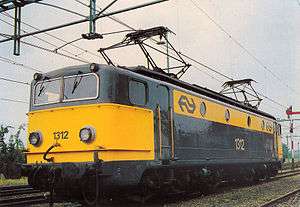NS Class 1300
| NS Class 1300 | |||||||||||||||||||||
|---|---|---|---|---|---|---|---|---|---|---|---|---|---|---|---|---|---|---|---|---|---|
 | |||||||||||||||||||||
| |||||||||||||||||||||
| |||||||||||||||||||||
| |||||||||||||||||||||
| |||||||||||||||||||||
The Nederlandse Spoorwegen (NS) Class 1300 was a Dutch locomotive in service for 48 years from 1952 until 2000.
It was built at the same time as the NS Class 1100 at Alsthom and was based on the SNCF Class CC 7100. The Class 1300 is a bigger 6-axle version of the Class 1100.
The first loco, the 1301, was delivered in 1952 and was first used at the opening of the electric service between Zwolle and Groningen.
After being in service for less than a year 1303 was damaged beyond repair when it collided with EMU 642 at Weesp on June 19, 1953. After this accident Alsthom delivered a new loco that was originally to be delivered as a CC 7100 to the SNCF. 1303 was scrapped on the spot although some equipment was salvaged to be used in replacement loco 1311.
The locos numbered 1312-1316 were delivered in 1956 in a Berlin blue colour scheme (the locos delivered in 1952 were delivered in a turquoise colour scheme, but were painted Berlin blue in 1955).
During the 1980s the entire Class 1300 got prolonging maintenance and were painted yellow, with a big NS logo at the side. Also, the locos were all named after a Dutch city:
- 1301 Dieren
- 1302 Woerden
- 1304 Culemborg
- 1305 Alphen aan den Rijn
- 1306 Brummen
- 1307 Etten-Leur
- 1308 Nunspeet
- 1309 Susteren
- 1310 Bussum
- 1311 Best
- 1312 Zoetermeer
- 1313 Uitgeest
- 1314 Hoorn
- 1315 Tiel
- 1316 Geldermalsen
In 2000 the last locomotives were withdrawn from service. 1302, 1304, 1312 and 1315 have been preserved.
In 2015 number 1304 came back into service for private operator HSL Logistik.
Number 1312 is the working representative of this class for the Dutch Railway Museum.
| Wikimedia Commons has media related to NS Class 1300. |